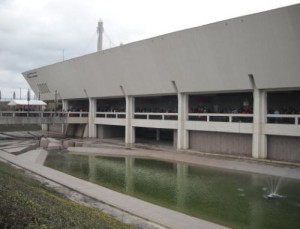The Institute of Texan Cultures (“ITC”) is hard to really pin down simply. The building was the Texas Pavilion in HemisFair ’68 and the ITC is now a museum dedicated to the cultural origins of Texans, I guess? Inside the museum, there are sections dedicated to the prehistoric peoples of Texas, the indigenous population, and many of the (largely European) nations that had immigrants to Texas (Germany has a large section which includes an entire gazebo). There is also a display on the history of Jewish people in Texas, and an entire sharecropper’s cabin from the early 1900s.

Outside the building is what is known as the “back forty.” This area holds a number of buildings representing different eras of Texas’s history. There’s a one-room schoolhouse, an adobe house, a “dogtrot” log cabin (that is a kind of cabin that has two separate buildings connected by a sort of breezeway), a stone building that is supposed to represent the forts of Texas, and a barn.
From what I can determine, the ITC is a pretty standard fourth-grade field trip in San Antonio. In Texas, fourth grade is dedicated to Texas state history. I was one of the chaperones when Alex’s fourth-grade class made the trip, so I’ve had that experience, at least.
Once you’re out of fourth grade, however, the only time most residents are likely (though not, of course, guaranteed) to return is for one of the two annual festivals held there. The first weekend after the lunar new year is the Asian New Year festival. City organizations representing many of the cultures of Asia that have communities here come and sell representative samples of food. Traditionally, I get a masala dosa (from the Indian vendor), a bubble drink (from Tong’s Thai) and a kalua pork (from the Hawaiian vendor). Martial arts and Asian dancing organizations give demonstrations and/or performances, as appropriate, and the San Antonio Bonsai Society and Ikebana San Antonio also have displays on the ground floor of the building.
The other festival is the Texas Folklife Festival, held the second weekend of June. The Texas Folklife Festival is a much bigger deal. You can buy the t-shirts not just at the event but in stores as well. A lot of the same Asian vendors are there for the Folklife Festival, and there are a lot of other cultures represented, including a Native American booth, and a large number of European cultures (Germany, Belgium, Scotland, Ireland, and others — in past years they have had a Czech booth and a Spanish booth, but neither has been there in recent years). I at the very least have to get a Belgian waffle, though they’re just ordinary waffles and not liège waffles. But regular waffles are okay in my opinion. Sandy Oaks Olive Orchard traditionally has a vendor table, and I bought a sapling from them back in, oh, 2006 or 2007, I think. I had my first crop of olives in 2014. It rained too much for olives in 2015. It may have rained enough that it won’t fruit this year, either.
All in all, though, even if you aren’t there for one of the festivals (though if you are able to be there for either one, I highly recommend going), it’s a nice little history museum and, if you didn’t attend fourth grade in San Antonio, it’s probably worth a trip.
